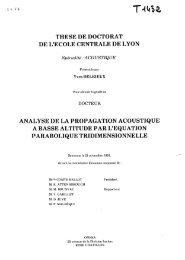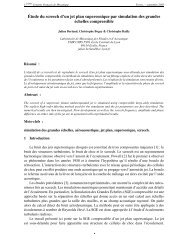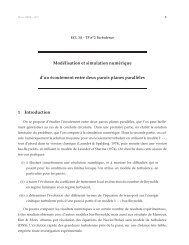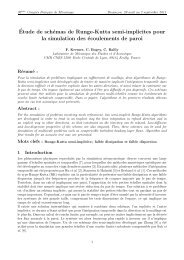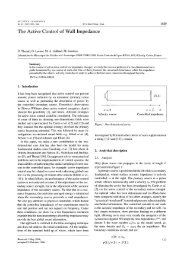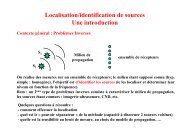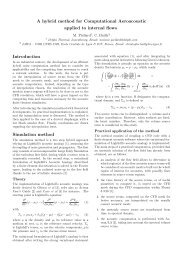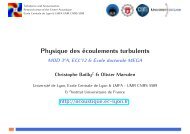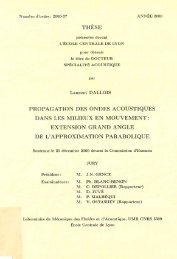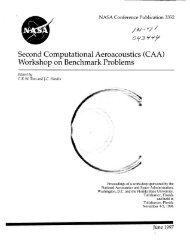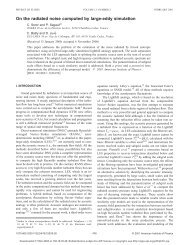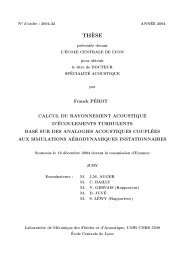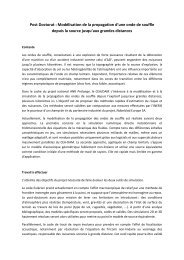ERCOFTAC Bulletin - Centre Acoustique
ERCOFTAC Bulletin - Centre Acoustique
ERCOFTAC Bulletin - Centre Acoustique
Create successful ePaper yourself
Turn your PDF publications into a flip-book with our unique Google optimized e-Paper software.
OASPL (dB)<br />
×<br />
×<br />
×<br />
×<br />
×<br />
×<br />
10dB<br />
×<br />
×<br />
×<br />
×<br />
×<br />
×<br />
0 20 40 60 80<br />
θ (degree)<br />
Figure 6: Overall sound pressure level determined by<br />
(cja using eqs. (Eq. (10)) and (Eq. (4))), · (cja<br />
using eqs. (Eq. (3)) and (Eq. (4))), with “×" (cja<br />
using eq. (Eq. (10))), · with “×" (cja using<br />
eq. (Eq. (3))).<br />
frequency of StD = 1.5 the sound spectrum of the sideline<br />
direction shows a marked decrease since at the current<br />
low Reynolds number the turbulence energy decay<br />
occurs immediately in the high frequency band. The effect<br />
of the modified entropy source is clearly observed<br />
over the wide frequency band of the downstream and<br />
the sideline acoustics. Especially, in the sideline acoustics<br />
the first order approximation involved in the original<br />
formulation overestimates the low frequency acoustics.<br />
However, in the downstream direction the modification<br />
of the entropy source impacts on the high frequency<br />
noise. Accoding to the recent study concerning<br />
jet noise mechanisms [24] the sound spectrum is dominated<br />
by large turbulence structures and fine-scale turbulence.<br />
The large turbulence structure dominates the<br />
jet downstream acoustics. In other words, the modified<br />
entropy source term describes with accuracy the acoustic<br />
cancellation in a high frequency band. The acoustic cancellation<br />
is involved in the convection of the large scale<br />
turbulent structures.<br />
4 Conclusion<br />
To understand the impact of an inhomogeneous density<br />
field on the acoustics, the flow field and the acoustic field<br />
of a helium-mixture and a hot-air coaxial jet configuration<br />
have been analyzed. The hot-air coaxial jet has<br />
an equivalent density distribution as the helium-mixture<br />
coaxial jet. The comparison of the turbulent flow fields<br />
shows almost an identical distribution of the mean velocity<br />
and the turbulence intensity. The strong density<br />
gradient in the coaxial jets enhances the turbulent mixing<br />
resulting in a strong increase of the Reynolds stress<br />
distribution near the end of the potential core. The comparison<br />
of the old and the new entropy-source formulation<br />
shows the impact of the inhomogeneous density distribution<br />
on the acoustic field determined by the hybrid<br />
LES /APE approach. The present analysis of the acoustic<br />
source terms was detailed by considering two features<br />
characterizing the sound generation in the hot-air coaxial<br />
jet. The first feature is the downstream acoustics due to<br />
the large scale turbulence at the end of the jet potential<br />
×<br />
×<br />
×<br />
×<br />
×<br />
×<br />
SPL (dB)<br />
×<br />
×<br />
×<br />
×<br />
×<br />
×<br />
× ×<br />
× ×<br />
×<br />
×<br />
× ×<br />
× × × ×<br />
10dB<br />
St D<br />
×<br />
×<br />
×<br />
×<br />
ω<br />
×<br />
×<br />
-2<br />
×<br />
×<br />
×<br />
× ×<br />
×<br />
×<br />
×<br />
×<br />
× ×<br />
×<br />
×<br />
×<br />
×<br />
× ×<br />
0.5 1 1.5 2 2.5<br />
Figure 7: Acoustic power spectra of acoustic pressure<br />
for a helium-air mixture jet determined by (cja<br />
using eqs. (Eq. (10)) and (Eq. (4))), · (cja using<br />
eqs. (Eq. (3)) and (Eq. (4))), with “×" (cja using<br />
eq. (Eq. (10))), · with “×" (cja using eq. (Eq. (3))),<br />
4 black lines in the upper (θ = 24 deg), 4 blue lines in<br />
the lower (θ = 90 deg).<br />
core and the second feature is the sideline acoustics the<br />
low-frequency acoustics of which was enhanced by the<br />
density gradient. Using the excess density expression<br />
the APE-4 system quantifies the detailed acoustics generated<br />
by an inhomogeneous flow field. The original noise<br />
source formulation overpredicted the acoustic radiation<br />
due to the missing contribution of small-scale turbulence.<br />
The deficit of this high-order source contribution could<br />
lead to an overestimate of the low frequency acoustics<br />
since at the low frequency band the low-order acoustics<br />
is a more efficient sound source than the high-order component.<br />
The proposed new entropy term based on the<br />
excess density does not introduce this surplus acoustics.<br />
References<br />
[1] Tester, B. and Morfey, C. L., “Developments in<br />
Jet Noise Modelling-Theoretical Predictions and<br />
Comparisons with Measured Data,” J. Sound Vib.,<br />
Vol. 46, No. 1, 1976, pp.79–103.<br />
[2] Morfey, C. L., Szewczyk, V., and Tester, B., “New<br />
Scaling Laws for Hot and Cold Jet Mixing Noise<br />
Based on a Geometric Acoustic Model,” J. Sound<br />
Vib., Vol. 61, No. 2, 1978, pp.255–292.<br />
[3] Li, Y., Roberts, W., Brown, M., and Gord, J.,<br />
“Acoustic Damping Rate Measurements in Binary<br />
Mixtures of Atomic Species via Transient-Grating<br />
Spectroscopy,” Exp. Fluids, Vol. 39, 2005, pp.687–<br />
693.<br />
[4] Goldstein, M., “An Exact form of Lilley’s Equation<br />
with a Velocity Quadrupole/Temperature Dipole<br />
Source Term,” J. Fluid Mech., Vol. 443, 2001,<br />
pp.231–236.<br />
[5] Morfey, C. L. and Tester, B., “Noise Measurements<br />
in a Free Jet Flight Simulation Facility : Shear Layer<br />
Refraction and Facility-to-Flight Corrections,” J.<br />
Sound Vib., Vol. 54, No. 1, 1977, pp.83–106.<br />
<strong>ERCOFTAC</strong> <strong>Bulletin</strong> 90 19



